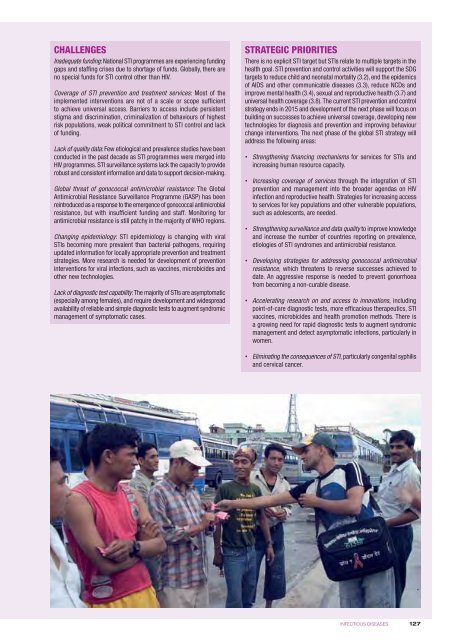You also want an ePaper? Increase the reach of your titles
YUMPU automatically turns print PDFs into web optimized ePapers that Google loves.
CHALLENGES<br />
Inadequate funding: National STI programmes are experiencing funding<br />
gaps and staffing crises due <strong>to</strong> shortage of funds. Globally, there are<br />
no special funds for STI control other than HIV.<br />
Coverage of STI prevention and treatment services: Most of the<br />
implemented interventions are not of a scale or scope sufficient<br />
<strong>to</strong> achieve universal access. Barriers <strong>to</strong> access include persistent<br />
stigma and discrimination, criminalization of behaviours of highest<br />
risk populations, weak political commitment <strong>to</strong> STI control and lack<br />
of funding.<br />
Lack of quality data: Few etiological and prevalence studies have been<br />
conducted in the past decade as STI programmes were merged in<strong>to</strong><br />
HIV programmes. STI surveillance systems lack the capacity <strong>to</strong> provide<br />
robust and consistent information and data <strong>to</strong> support decision-making.<br />
Global threat of gonococcal antimicrobial resistance: The Global<br />
Antimicrobial Resistance Surveillance Programme (GASP) has been<br />
reintroduced as a response <strong>to</strong> the emergence of gonococcal antimicrobial<br />
resistance, but with insufficient funding and staff. Moni<strong>to</strong>ring for<br />
antimicrobial resistance is still patchy in the majority of WHO regions.<br />
Changing epidemiology: STI epidemiology is changing with viral<br />
STIs becoming more prevalent than bacterial pathogens, requiring<br />
updated information for locally appropriate prevention and treatment<br />
strategies. More research is needed for development of prevention<br />
interventions for viral infections, such as vaccines, microbicides and<br />
other new technologies.<br />
Lack of diagnostic test capability: The majority of STIs are asymp<strong>to</strong>matic<br />
(especially among females), and require development and widespread<br />
availability of reliable and simple diagnostic tests <strong>to</strong> augment syndromic<br />
management of symp<strong>to</strong>matic cases.<br />
STRATEGIC PRIORITIES<br />
There is no explicit STI target but STIs relate <strong>to</strong> multiple targets in the<br />
health goal. STI prevention and control activities will support the SDG<br />
targets <strong>to</strong> reduce child and neonatal mortality (3.2), end the epidemics<br />
of AIDS and other communicable diseases (3.3), reduce NCDs and<br />
improve mental health (3.4), sexual and reproductive health (3.7) and<br />
universal health coverage (3.8). The current STI prevention and control<br />
strategy ends in 2015 and development of the next phase will focus on<br />
building on successes <strong>to</strong> achieve universal coverage, developing new<br />
technologies for diagnosis and prevention and improving behaviour<br />
change interventions. The next phase of the global STI strategy will<br />
address the following areas:<br />
• Strengthening financing mechanisms for services for STIs and<br />
increasing human resource capacity.<br />
• Increasing coverage of services through the integration of STI<br />
prevention and management in<strong>to</strong> the broader agendas on HIV<br />
infection and reproductive health. Strategies for increasing access<br />
<strong>to</strong> services for key populations and other vulnerable populations,<br />
such as adolescents, are needed.<br />
• Strengthening surveillance and data quality <strong>to</strong> improve knowledge<br />
and increase the number of countries reporting on prevalence,<br />
etiologies of STI syndromes and antimicrobial resistance.<br />
• Developing strategies for addressing gonococcal antimicrobial<br />
resistance, which threatens <strong>to</strong> reverse successes achieved <strong>to</strong><br />
date. An aggressive response is needed <strong>to</strong> prevent gonorrhoea<br />
<strong>from</strong> becoming a non-curable disease.<br />
• Accelerating research on and access <strong>to</strong> innovations, including<br />
point-of-care diagnostic tests, more efficacious therapeutics, STI<br />
vaccines, microbicides and health promotion methods. There is<br />
a growing need for rapid diagnostic tests <strong>to</strong> augment syndromic<br />
management and detect asymp<strong>to</strong>matic infections, particularly in<br />
women.<br />
• Eliminating the consequences of STI, particularly congenital syphilis<br />
and cervical cancer.<br />
INFECTIOUS DISEASES<br />
127


